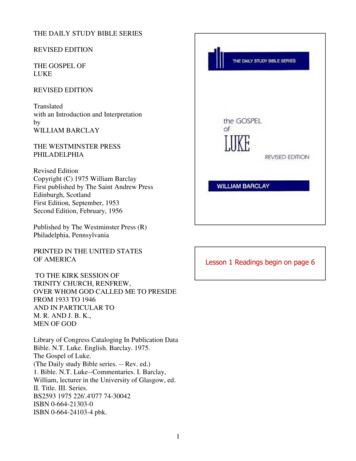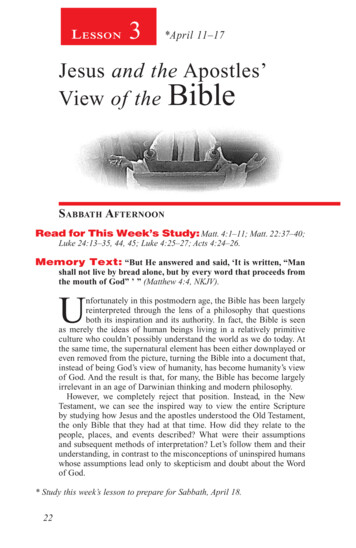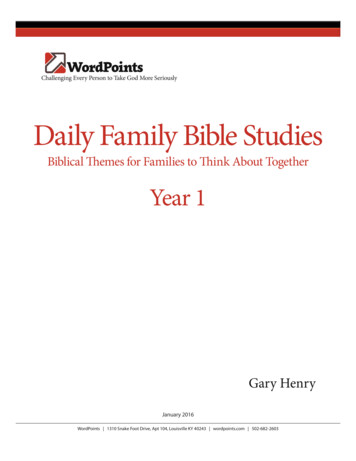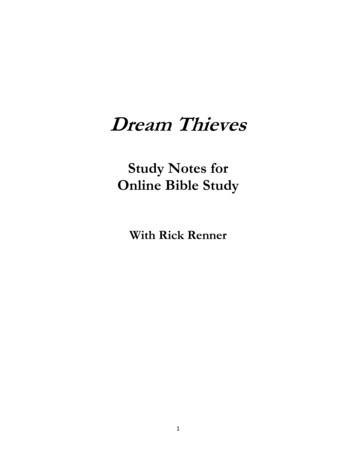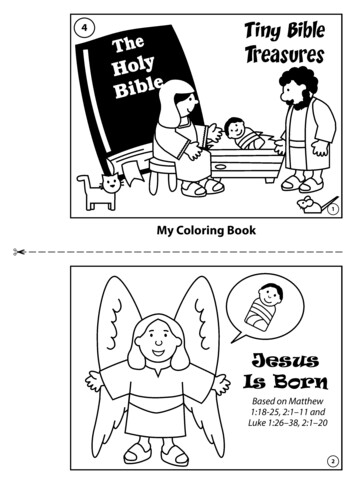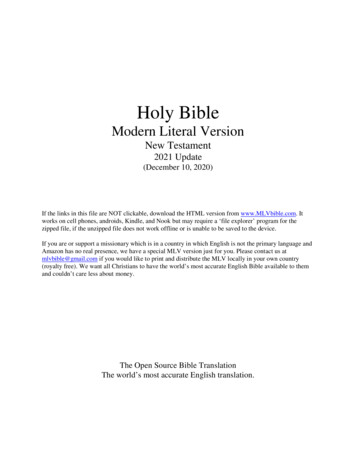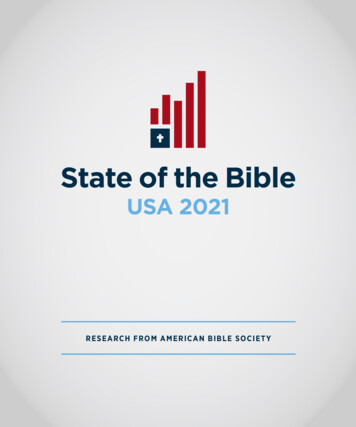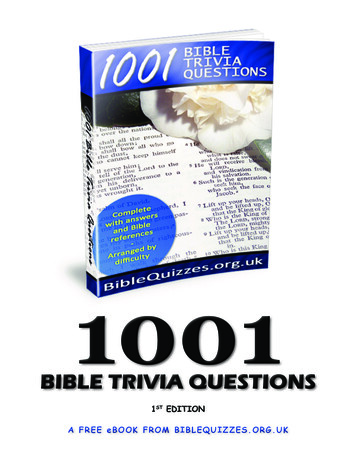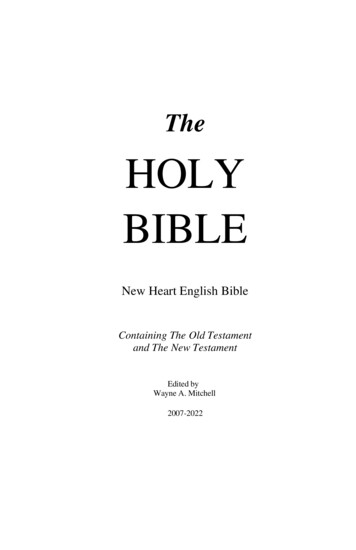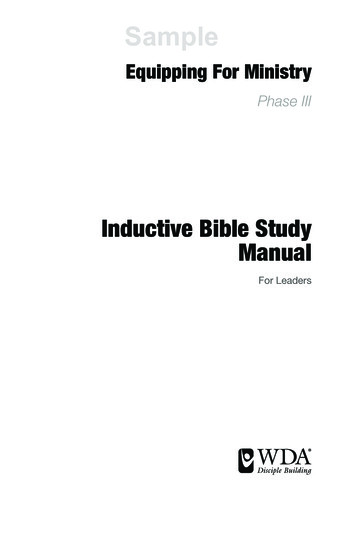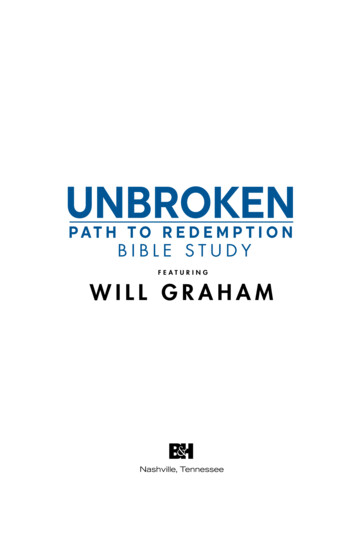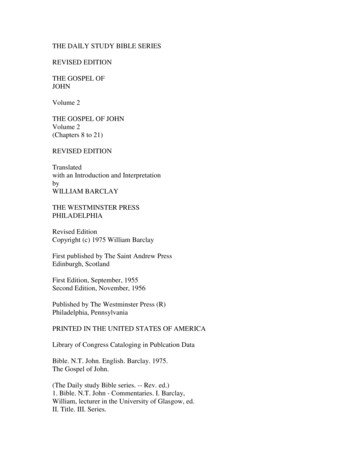
Transcription
THE DAILY STUDY BIBLE SERIESREVISED EDITIONTHE GOSPEL OFJOHNVolume 2THE GOSPEL OF JOHNVolume 2(Chapters 8 to 21)REVISED EDITIONTranslatedwith an Introduction and InterpretationbyWILLIAM BARCLAYTHE WESTMINSTER PRESSPHILADELPHIARevised EditionCopyright (c) 1975 William BarclayFirst published by The Saint Andrew PressEdinburgh, ScotlandFirst Edition, September, 1955Second Edition, November, 1956Published by The Westminster Press (R)Philadelphia, PennsylvaniaPRINTED IN THE UNITED STATES OF AMERICALibrary of Congress Cataloging in Publcation DataBible. N.T. John. English. Barclay. 1975.The Gospel of John.(The Daily study Bible series. -- Rev. ed.)1. Bible. N.T. John - Commentaries. I. Barclay,William, lecturer in the University of Glasgow, ed.II. Title. III. Series.
BS2613 1975 226'.5'077 74-30031ISBN 0-664-21305-7 (v.2)ISBN 0-664-24105-0 (v.2) pbk.GENERAL INTRODUCTIONThe Daily Study Bible series has always had one aim--to convey the results ofscholarship to the ordinary reader. A. S. Peake delighted in the saying that he was a"theological middleman", and I would be happy if the same could be said of me in regardto these volumes. And yet the primary aim of the series has never been academic. It couldbe summed up in the famous words of Richard of Chichester's prayer--to enable men andwomen "to know Jesus Christ more clearly, to love him more dearly, and to follow himmore nearly".It is all of twenty years since the first volume of The Daily Study Bible was published.The series was the brain-child of the late Rev. Andrew McCosh, M.A., S.T.M., the thenSecretary and Manager of the Committee on Publications of the Church of Scotland, andof the late Rev. R. G. Macdonald, O.B.E., M.A., D.D., its Convener.It is a great joy to me to know that all through the years The Daily Study Bible has beenused at home and abroad, by minister, by missionary, by student and by layman, and thatit has been translated into many different languages. Now, after so many printings, it hasbecome necessary to renew the printer's type and the opportunity has been taken torestyle the books, to correct some errors in the text and to remove some references whichhave become outdated. At the same time, the Biblical quotations within the text havebeen changed to use the Revised Standard Version, but my own original translation of theNew Testament passages has been retained at the beginning of each daily section.There is one debt which I would be sadly lacking in courtesy if I did not acknowledge.The work of revision and correction has been done entirely by the Rev. James Martin,M.A., B.D., Minister of High Carntyne Church, Glasgow. Had it not been for him thistask would never have been undertaken, and it is impossible for me to thank him enoughfor the selfless toil he has put into the revision of these books.It is my prayer that God may continue to use The Daily Study Bible to enable men betterto understand His word.Glasgow WILLIAM BARCLAYCONTENTSGeneral IntroductionWretchedness and Pity (Jn. 7:53-8:11)The Light Men Failed to Recognize (Jn. 8:12-20)The Fatal Incomprehension (Jn. 8:21-30)
The Tragic Incomprehension (Jn. 8:21-30)The True Discipleship (Jn. 8:31-32)Freedom and Slavery (Jn. 8:33-36)Real Sonship (Jn. 8:37-41)Children of the Devil (Jn. 8:41-45)The Great Indictment and the Shining Faith (Jn. 8:46-50)The Life and the Glory (Jn. 8:51-55)The Tremendous Claim (Jn. 8:56-59)Light for the Blind Eyes (Jn. 9:1-5)The Method of a Miracle (Jn. 9:6-12)Prejudice and Conviction (Jn. 9:13-16)The Pharisees Defied (Jn. 9:17-35)Revelation and Condemnation (Jn. 9:35-41)Greater and Greater (Jn. 9)The Shepherd and his Sheep (Jn. 10:1-6)The Door to Life (Jn. 10:7-10)The True and the False Shepherd (Jn. 10:11-15)The Ultimate Unity (Jn. 10:16)Love's Choice (Jn. 10:17-18)Madman or Son of God (Jn. 10:19-21)The Claim and the Promise (Jn. 10:22-28)The Tremendous Trust and the Tremendous Claim (Jn. 10:29-30)Inviting the Acid Test (Jn. 10:31-39)Peace Before the Storm (Jn. 10:40-41)On the Road to Glory (Jn. 11:1-5)Time Enough but not too Much (Jn. 11:6-10)The Day and the Night (Jn. 11:6-10)The Man who would not Quit (Jn. i 1:11-16)The House of Mourning (Jn. 11:17-19)The Resurrection and the Life (Jn. 11:20-27)Thee Emotion of Jesus (Jn. 11:28-33)The Voice that Wakes the Dead (Jn. 11:34-44)The Raising of Lazarus (Jn. 11:1-44)The Tragic Irony (Jn. 11:47-53)Jesus, the Outlaw (Jn. 11:54-57)Love's Extravagance (Jn. 12:1-8)A Plan to Destroy the Evidence (Jn. 12:9-11)A King's Welcome (Jn. 12:12-19)The Seeking Greeks (Jn. 12:20-22)The Amazing Paradox (Jn. 12:23-26)From Tension to Certainty (Jn. 12:27-34)Sons of the Light (Jn. 12:35-36)Blind Unbelief (Jn. 12:37-41)The Coward's Faith (Jn. 12:42-43)The Inescapable Judgment (Jn. 12:44-50)The Royalty of Service (Jn. 13:1-17)
The Essential Washing (Jn. 13:1-17)The Shame of Disloyalty and the Glory of Fidelity (Jn. 13:18-20)Love's Last Appeal (Jn. 13:21-30)The Fourfold Glory (Jn. 13:31-32)The Farewell Command (Jn. 13:33-35)The Faltering Loyalty (Jn. 13:36-38)The Promise of Glory (Jn. 14:1-3)The Promise of Glory (Jn. 14:1-3)The Way, the Truth, and the Life (Jn. 14:4-6)The Vision of God (Jn. 14:7-11)The Tremendous Promises (Jn. 14:12-14)The Promised Helper (Jn. 14:15-17)The Way to Fellowship and to Revelation (Jn. 14:18-24)The Bequests of Christ (Jn. 14:25-3 1)The Vine and the Branches (Jn. 15:1-10)The Life of Jesus's Chosen People (Jn. 15:11-17)The World's Hatred (Jn. 15:18-21)Knowledge and Responsibility (Jn. 15:22-25)Witness Divine and Human (Jn. 15:26-27)Warning and Challenge (Jn. 16:1-4)The Work of the Holy Spirit (Jn. 16:5-11)The Spirit of Truth (Jn. 16:12-15)Sorrow Turned to Joy (Jn. 16:16-24)The Direct Access (Jn. 16:25-28)Christ and His Gifts (Jn. 16:29-33)The Glory of the Cross (Jn. 17:1-5)Eternal Life (Jn. 17:1-5)The Work of Jesus (Jn. 17:6-8)The Meaning of Discipleship (Jn. 17:6-8)Jesus's Prayer for His Disciples (Jn. 17:9-19)A Glimpse of the Future (Jn. 17:20-21)The Gift and the Promise of Glory (Jn. 17:22-26)The Arrest in the Garden (Jn. 18:1-11)Jesus before Annas (Jn. 18:12-14, 19-24)The Hero and the Coward (Jn. 18:15-18, 25-27)Jesus and Pilate (Jn. 18:28-19:16)The Way to the Cross (Jn. 19:17-22)The Gamblers at the Cross (Jn. 19:23-24)A Son's Love (Jn. 19:25-27)The Triumphant Ending (Jn. 19:28-30)The Water and the Blood (Jn. 19:31-37)The Last Gifts to Jesus (Jn. 19:38-42)Bewildered Love (Jn. 20:1-10)The Great Discovery (Jn. 20:1-10)The Great Recognition (Jn. 20:11-18)Sharing the Good News (Jn. 20:11-18)
The Commission of Christ (Jn. 20:19-23)The Doubter Convinced (Jn. 20:24-29)Thomas in the After Days (Jn. 20:24-29)The Aim of the Gospel (Jn. 20:30-31)The Risen Lord (Jn. 21:1-14)The Reality of the Resurrection (Jn. 21:1-14)The Universality of the Church (Jn. 21:1-14)The Shepherd of Christ's Sheep (Jn. 21:15-19)The Witness to Christ (Jn. 21:20-24)The Limitless Christ (Jn. 21:25)Note on the Story of the Woman Taken in Adultery (Jn. 8:2-11)Note on the Date of the CrucifixionFurther ReadingJOHNWRETCHEDNESS AND PITYJn. 7:53-8:11And each of them went to his own house; but Jesus went to the Mount of Olives. Early inthe morning he was again in the Temple precincts, and all the people came to him. He satdown and went on teaching them. The scribes and Pharisees brought a woman arrestedfor adultery. They set her in the midst and said to him: "Teacher, this woman wasarrested as she was committing adultery--in the very act. In the law Moses enjoined us tostone women like this. What do you say about her?" They were testing him when theysaid this, so that they might have some ground on which to accuse him. Jesus stoopeddown and wrote with his finger on the ground. When they went on asking him theirquestion, he straightened himself and said to them: "Let the man among you who iswithout sin be the first to cast a stone at her." And again he bent down and wrote with hisfinger on the ground. One by one those who had heard what he said went out, beginningfrom the eldest down to the youngest. So Jesus was left alone, and the woman was stillthere in the midst. Jesus straightened himself and said to her: "Woman, where are they?Has no one condemned you?" She said: "No one, sir." Jesus said: "I am not going to passjudgment on you either. Go, and from now on, sin no more."[This incident is not included in all the ancient manuscripts and appears only in afootnote in the Revised Standard Version; see: NOTE ON THE STORY OF THEWOMAN TAKEN IN ADULTERY]The scribes and Pharisees were out to get some charge on which they could discreditJesus; and here they thought they had impaled him inescapably on the horns of adilemma. When a difficult legal question arose, the natural and routine thing was to takeit to a Rabbi for a decision. So the scribes and Pharisees approached Jesus as a Rabbiwith a woman taken in adultery.
In the eyes of the Jewish law adultery was a serious crime. The Rabbis said: "Every Jewmust die before he will commit idolatry, murder or adultery." Adultery was, in fact one ofthe three gravest sins and it was punishable by, death, although there were certaindifferences in respect of the way in which the death penalty was to be carried out.Lev.20:10 lays it down: "If a man commits adultery with the wife of his neighbour, boththe adulterer and the adulteress shall be put to death." There the method of death is notspecified. Deut.22:13-24 lays down the penalty in the case of a girl who is alreadybetrothed. In a case like that she and the man who seduced her are to be brought outsidethe city gates, "and you shall stone them to death with stones." The Mishnah, that is, theJewish codified law, states that the penalty for adultery is strangulation, and even themethod of strangulation is laid down. "The man is to be enclosed in dung up to his knees,and a soft towel set within a rough towel is to be placed around his neck (in order that nomark may be made, for the punishment is God's punishment). Then one man draws in onedirection and another in the other direction, until he be dead." The Mishnah reiterates thatdeath by stoning is the penalty for a girl who is betrothed and who then commits adultery.From the purely legal point of view the scribes and Pharisees were perfectly correct. Thiswoman was liable to death by stoning.The dilemma into which they sought to put Jesus was this: If he said that the womanought to be stoned to death, two things followed. First, he would lose the name he hadgained for love and for mercy and never again would be called the friend of sinners.Second, he would come into collision with the Roman law, for the Jews had no power topass or carry out the death sentence on anyone. If he said that the woman should bepardoned, it could immediately be said that he was teaching men to break the law ofMoses, and that he was condoning and even encouraging people to commit adultery. Thatwas the trap in which the scribes and Pharisees sought to entrap Jesus. But he turned theirattack in such a way that it recoiled against themselves.At first Jesus stooped down and wrote with his finger on the ground. Why did he do that?There may be four possible reasons.(i) He may quite simply have wished to gain time and not be rushed into a decision. Inthat brief moment he may have been both thinking the thing out and taking it to God.(ii) Certain manuscripts add, "As though he did not hear them." Jesus may well havedeliberately forced the scribes and Pharisees to repeat their charges, so that, in repeatingthem, they might possibly realize the sadistic cruelty which lay behind them.(iii) Seeley in Ecce Homo makes an interesting suggestion. "Jesus was seized with anintolerable sense of shame. He could not meet the eye of the crowd, or of the accusers,and perhaps at that moment least of all of the woman. In his burning embarrassmentand confusion he stooped down so as to hide his face, and began writing with his fingersupon the ground." It may well be that the leering, lustful look on the faces of the scribesand Pharisees, the bleak cruelty in their eyes, the prurient curiosity of the crowd, theshame of the woman, all combined to twist the very heart of Jesus in agony and pity, sothat he hid his eyes.
(iv) By far the most interesting suggestion emerges from certain of the later manuscripts.The Armenian translates the passage this way: "He himself, bowing his head, was writingwith his finger on the earth to declare their sins; and they were seeing their several sinson the stones." The suggestion is that Jesus was writing in the dust the sins of the verymen who were accusing the woman. There may be something in that. The normal Greekword for to write is graphein (GSN1125); but here the word used is katagraphein, whichcan mean to write down a record against someone. (One of the meanings of kata(GSN2596) is against). So in Jb.13:26 Job says: "Thou writest (katagraphein) bitterthings against me." It may be that Jesus was confronting those self-confident sadists withthe record of their own sins.However that may be, the scribes and Pharisees continued to insist on an answer--andthey got it. Jesus said in effect: "All right! Stone her! But let the man that is without sinbe the first to cast a stone." It may well be that the word for without sin (anamartetos,GSN0361) means not only without sin, but even without a sinful desire. Jesus wassaying: "Yes, you may stone her--but only if you never wanted to do the same thingyourselves." There was a silence--and then slowly the accusers drifted away.So Jesus and the woman were left alone. As Augustine put it: "There remained a greatmisery (miseria) and a great pity (misericordia)." Jesus said to the woman: "Has no onecondemned you?" "No one, sir," she said. Jesus said: "I am not for the moment going topass judgment on you either. Go, and make a new start, and don't sin any more."WRETCHEDNESS AND PITYJn. 7:53-8:11 (continued)This passage shows us two things about the attitude of the scribes and the Pharisees.(i) It shows us their conception of authority. The scribes and the Pharisees were the legalexperts of the day; to them problems were taken for decision. It is clear that to themauthority was characteristically critical, censorious and condemnatory. That authorityshould be based on sympathy, that its aim should be to reclaim the criminal and thesinner, never entered their heads. They conceived of their function as giving them theright to stand over others like grim invigilators, to watch for every mistake and everydeviation from the law, and to descend on them with savage and unforgiving punishment;they never dreamed that it might lay upon them the obligation to cure the wrongdoer.There are still those who regard a position of authority as giving them the right tocondemn and the duty to punish. They think that such authority as they have has giventhem the right to be moral watch-dogs trained to tear the sinner to pieces; but all trueauthority is founded on sympathy. When George Whitefield saw the criminal on the wayto the gallows, he uttered the famous sentence: "There, but for the grace of God, go I."The first duty of authority is to try to understand the force of the temptations which drovethe sinner to sin and the seductiveness of the circumstances in which sin became so
attractive. No man can pass judgment on another unless he at least tries to understandwhat the other has come through. The second duty of authority is to seek to reclaim thewrongdoer. Any authority which is solely concerned with punishment is wrong; anyauthority, which, in its exercise, drives a wrongdoer either to despair or to resentment, isa failure. The function of authority is not to banish the sinner from all decent society, stillless to wipe him out; it is to make him into a good man. The man set in authority must belike a wise physician; his one desire must be to heal.(ii) This incident shows vividly and cruelly the attitude of the scribes and Pharisees topeople. They were not looking on this woman as a person at all; they were looking on heronly as a thing, an instrument whereby they could formulate a charge against Jesus. Theywere using her, as a man might use a tool, for their own purposes. To them she had noname, no personality, no feelings; she was simply a pawn in the game whereby theysought to destroy Jesus.It is always wrong to regard people as things; it is always unchristian to regard people ascases. It was said of Beatrice Webb, afterwards Lady Passfield, the famous economist,that "she saw men as specimens walking." Dr. Paul Tournier in A Doctor's Casebooktalks of what he calls "the personalism of the Bible." He points out how fond the Bible isof names. God says to Moses: "I know you by name" (Exo.33:17). God said to Cyrus; "Itis I, the God of Israel, who call you by your name" (Isa.45:3). There are whole pages ofnames in the Bible. Dr. Tournier insists that this is proof that the Bible thinks of peoplefirst and foremost, not as fractions of the mass, or abstractions, or ideas, or cases, but aspersons. "The proper name," Dr. Tournier writes, "is the symbol of the person. If I forgetmy patients' names, if I say to myself, Ah! There's that gall-bladder type or thatconsumptive that I saw the other day,' I am interesting myself more in their gall-bladdersor in their lungs than in themselves as persons." He insists that a patient must be always aperson, and never a case.It is extremely unlikely that the scribes and the Pharisees even knew this woman's name.To them she was nothing but a case of shameless adultery that could now be used as aninstrument to suit their purposes. The minute people become things the spirit ofChristianity is dead.God uses his authority to love men into goodness; to God no person ever becomes athing. We must use such authority as we have always to understand and always at least totry to mend the person who has made the mistake; and we will never even begin to dothat unless we remember that every man and woman is a person, not a thing.WRETCHEDNESS AND PITYJn. 7:53-8:11 (continued)Further, this incident tells us a great deal about Jesus and his attitude to the sinner.
(i) It was a first principle of Jesus that only the man who himself is without fault has theright to express judgment on the fault of others. "Judge not," said Jesus, "that you be notjudged" (Matt.7:1). He said that the man who attempted to judge his brother was like aman with a plank in his own eye trying to take a speck of dust out of someone else's eye(Matt.7:3-5). One of the commonest faults in life is that so many of us demand standardsfrom others that we never even try to meet ourselves; and so many of us condemn faultsin others which are glaringly obvious in our own lives. The qualification for judging isnot knowledge--we all possess that; it is achievement in goodness--none of us is perfectthere. The very facts of the human situation mean that only God has the right to judge, forthe simple reason that no man is good enough to judge any other.(ii) It was also a first principle with Jesus that our first emotion towards anyone who hasmade a mistake should be pity. It has been said that the duty of the doctor is "sometimesto heal, often to afford relief and always to bring consolation." When a person sufferingfrom some ailment is brought to a doctor, he does not regard him with loathing even if heis suffering from a loathsome disease. In fact the physical revulsion which is sometimesinevitable is swallowed up by the great desire to help and to heal. When we areconfronted with someone who has made a mistake, our first feeling ought to be, not, "I'llhave nothing more to do with someone who could act like that," but, "What can I do tohelp? What can I do to undo the consequences of this mistake?" Quite simply, we mustalways extend to others the same compassionate pity we would wish to be extended toourselves if we were involved in a like situation.(iii) It is very important that we should understand just how Jesus did treat this woman. Itis easy to draw the wrong lesson altogether and to gain the impression that Jesus forgavelightly and easily, as if the sin did not matter. What he said was: "I am not going tocondemn you just now; go, and sin no more." In effect what he was doing was not toabandon judgment and say, "Don't worry; it's quite all right." What he did was, as it were,to defer sentence. He said, "I am not going to pass a final judgment now; go and provethat you can do better. You have sinned; go and sin no more and I'll help you all the time.At the end of the day we will see how you have lived." Jesus' attitude to the sinnerinvolved a number of things.(a) It involved the second chance. It is as if Jesus said to the woman: "I know you havemade a mess of things; but life is not finished yet; I am giving you another chance, thechance to redeem yourself." Someone has written the lines:"How I wish that there was some wonderful place Called the Land of Beginning Again,Where all our mistakes and all out heartaches And all our poor selfish grief Could bedropped like a shabby old coat at the door, And never put on again."In Jesus there is the gospel of the second chance. He was always intensely interested, notonly in what a person had been, but also in what a person could be. He did not say thatwhat they had done did not matter; broken laws and broken hearts always matter; but hewas sure that every man has a future as well as a past.
(b) It involved pity. The basic difference between Jesus and the scribes and Pharisees wasthat they wished to condemn; he wished to forgive. If we read between the lines of thisstory it is quite clear that they wished to stone this woman to death and were going totake pleasure in doing so. They knew the thrill of exercising the power to condemn; Jesusknew the thrill of exercising the power to forgive. Jesus regarded the sinner with pityborn of love; the scribes and Pharisees regarded him with disgust born of selfrighteousness.(c) It involved challenge. Jesus confronted this woman with the challenge of the sinlesslife. He did not say: "It's all right; don't worry; just go on as you are doing." He said: "It'sall wrong; go out and fight; change your life from top to bottom; go, and sin no more."Here was no easy forgiveness; here was a challenge which pointed a sinner to heights ofgoodness of which she had never dreamed. Jesus confronts the bad life with the challengeof the good.(d) It involved belief in human nature. When we come to think of it, it is a staggeringthing that Jesus should say to a woman of loose morals: "Go, and sin no more." Theamazing, heart-uplifting thing about him was his belief in men and women. When he wasconfronted with someone who had gone wrong, he did not say: "You are a wretched anda hopeless creature." He said: "Go, and sin no more." He believed that with his help thesinner has it in him to become the saint. His method was not to blast men with theknowledge--which they already possessed--that they were miserable sinners, but toinspire them with the unglimpsed discovery that they were potential saints.(e) It involved warning, clearly unspoken but implied. Here we are face to face with theeternal choice. Jesus confronted the woman with a choice that day--either to go back toher old ways or to reach out to the new way with him. This story is unfinished, for everylife is unfinished until it stands before God.[As we noted at the beginning, this story does not appear in all the ancient manuscripts. Adiscussion of the textual questions involved will be found under: NOTE ON THESTORY OF THE WOMAN TAKEN IN ADULTERY]THE LIGHT MEN FAILED TO RECOGNIZEJn. 8:12-20So Jesus again continued to speak to them. "I am the Light of the World," he said. "Hewho follows me will not walk in darkness, but he will have the light of life." So thePharisees said to him: "You are bearing witness about yourself. Your witness is not true."Jesus answered: "Even if I do bear witness about myself, my witness is true, because Iknow where I came from and where I am going to. You do not know where I came fromand where I am going to. You form your judgments on purely human grounds. I do notjudge anyone. But if I do form a judgment, my judgment is true, because I am not alonein my judgment, but I and the Father who sent me join in such a judgment. It standswritten in your law, that the witness of two persons is to be accepted as true. It is I who
witness about myself, and the Father who sent me also witnesses about me." They said tohim: "Where is your Father?" Jesus answered: "You know neither me nor my Father. Ifyou had known me you would know my Father too." He spoke these words in thetreasury while he was teaching in the Temple precincts; and no one laid violent handsupon him, because his hour had not yet come.The scene of this argument with the Jewish authorities was in the Temple treasury, whichwas in the Court of the Women. The first Temple court was the Court of the Gentiles; thesecond was the Court of the Women. It was so catted because women might not passbeyond it unless they were actually about to offer sacrifice on the altar which was in theCourt of the Priests. Round the Court of the Women there was a colonnade or porch; and,in that porch, set against the wall, there were thirteen treasure chests into which peopledropped their offerings. These were called The Trumpets because they were shaped liketrumpets, narrow at the top and swelling out towards the foot.The thirteen treasure chests all had their allotted offering. Into the first two were droppedthe half shekels which every Jew had to pay towards the upkeep of the Temple. Into thethird and fourth were dropped sums which would purchase the two pigeons which awoman had to offer for her purification after the birth of a child (Lev.12:8). Into the fifthwere put contributions towards the cost of the wood which was needed to keep the altarfire alight. Into the sixth were dropped contributions towards the cost of the incensewhich was used at the Temple services. Into the seventh went contributions towards theupkeep of the golden vessels which were used at these services. Sometimes a man or afamily set apart a certain sum to make some trespass- or thank-offering; into theremaining six trumpets people dropped any money which remained after such an offeringhad been made, or anything extra which they wished to offer.Clearly the Temple treasury would be a busy place, with a constant flow of worshipperscoming and going. There would be no better place to collect an audience of devoutpeople and to teach them than the Temple treasury.In this passage Jesus makes the great claim: "I am the Light of the World." It is verylikely that the background against which he made it made it doubly vivid and impressive.The festival with which John connects these discourses is the Festival of Tabernacles (Jn.7:2). We have already seen (Jn. 7:37) how its ceremonies lent drama to Jesus' claim togive to men the living water. But there was another ceremony connected with thisfestival.On the evening of its first day there was a ceremony called The Illumination of theTemple. It took place in the Court of the Women. The court was surrounded with deepgalleries, erected to hold the spectators. In the centre four great candelabra were prepared.When the dark came the four great candelabra were lit and, it was said, they sent such ablaze of light throughout Jerusalem that every courtyard was lit up with their brilliance.Then all night long, until cock-crow the next morning, the greatest and the wisest and theholiest men in Israel danced before the Lord and sang psalms of joy and praise while thepeople watched. Jesus is saying: "You have seen the blaze of the Temple illuminations
piercing the darkness of the night. I am the Light of the World, and, for the man whofollows me there will be light, not only for one exciting night, but for all the pathway ofhis life. The light in the Temple is a brilliant light, but in the end it flickers and dies. I amthe Light which lasts for ever."THE LIGHT MEN FAILED TO RECOGNIZEJn. 8:12-20 (continued)Jesus said: "He who follows me will not walk in darkness, but will have the light of life."The light of life means two things. The Greek can mean either the light which issues fromthe source of life or the light which gives life. In this passage it means both. Jesus is thevery light of God come among men; and he is the light which gives men life. Just as theflower can never blossom when it never sees the sunlight, so our lives can never flowerwith the grace and beauty they ought to have until they are irradiated with the light of thepresence of Jesus.In this passage Jesus talks of following himself. We often speak of following Jesus; weoften urge men to do so. What do we mean? The Greek for to follow is akolouthein(GSN0190); and its meanings combine to shed a flood of light on what it means to followJesus. Akolouthein (GSN0190) has five different but closely connected meanings.(i) It is often used of a soldier following his captain. On the long route marches, intobattle, in campaigns in strange lands, the soldier follows wherever the captain may lead.The Christian is the soldier whose commander is Christ.(ii) It is often used of a slave accompanying his master. Wherever the master goes theslave is in attendance upon him, always ready to spring to his service and to carry out thetasks he gives him to do. He is literally at his master's beck and call. The Christian is theslave whose joy it is always to serve Christ.(iii) It is often used of accepting a wise counsellor's opinion. When a man is in doubt hegoes to the expert, and if he is wise he accepts the judgment he receives. The Christian isthe man who guides his life and conduct by the counsel of Christ.(iv) It is often used of giving obedience to the laws of a city or a state. If a man is to be auseful member of any society or citizen of any community, he must agree to abide by itslaws. The
The Daily Study Bible series has always had one aim--to convey the results of scholarship to the ordinary reader. A. S. Peake delighted in the saying that he was a "theological middleman", and I would be happy if the same could be said of me in regard to these volumes. And yet the pr
